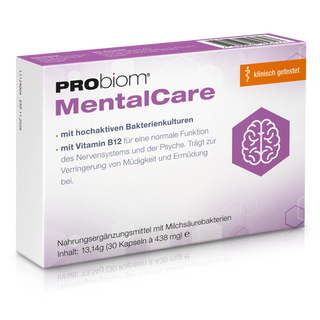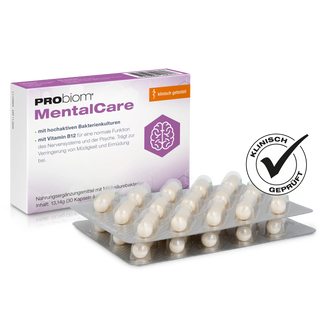Antibiotics are among the most important achievements of modern medicine. They save lives by fighting and controlling bacterial infections. But their use brings more than just benefits. One of the most common side effects is disruption of the natural intestinal flora. The result: digestive problems, diarrhea, and a weakened immune system. This is where probiotics come in. In this comprehensive article, you'll learn which probiotics are best for use when taking antibiotics, how they work, what you should pay attention to, and how you can optimally protect your gut.
Why probiotics are important with antibiotics
Antibiotics not only fight pathogenic bacteria, but also many of the beneficial gut bacteria that make up our microbiome . This imbalance becomes unbalanced, leading to, among other things:
-
Antibiotic-associated diarrhea (AAD)
-
increased susceptibility to infections (e.g. Clostridium difficile)
-
Bloating and cramps
-
can lead to immune deficiency. Probiotics help mitigate or completely prevent these side effects by supporting and regenerating the intestinal flora.
How probiotics work in the gut
Probiotics are live microorganisms—usually bacteria or yeasts—that, in sufficient quantities, provide health benefits. In the gut, they compete with pathogenic germs, strengthen the intestinal mucosa, and regulate the immune system. It's important that they arrive in the gut alive and can be active there.
Some of the positive mechanisms of action include:
-
Formation of antimicrobial substances
-
Reduction of inflammatory processes
-
Stimulation of mucous membranes and immune cells
-
Displacement of pathogenic germs through "colonization resistance"
The best probiotic strains for antibiotic therapy
Not every probiotic is the same. Selecting the right bacterial strains is crucial. The following have been particularly well-studied scientifically in relation to antibiotics:
-
Lactobacillus rhamnosus GG (LGG) : One of the best-documented probiotics worldwide, it is particularly effective against antibiotic-associated diarrhea in children and adults.
-
Saccharomyces boulardii : A probiotic yeast that is particularly stable against antibiotics because it does not belong to the bacterial group. It has been shown to be effective against Clostridium difficile.
-
Bifidobacterium lactis : Supports the intestinal barrier and can reduce inflammatory reactions in the intestine.
-
Lactobacillus acidophilus : Strengthens the mucous membrane and supports the immune system.
What you should pay attention to with probiotics
A good probiotic is characterized by the following features:
-
Scientifically tested strains with study evidence
-
Indication of the exact bacterial count (e.g. 10 billion CFU per dose)
-
Enteric-coated capsules or microencapsulation so that the bacteria arrive alive in the intestine
-
Free from harmful additives, sugar or preservatives
-
Sensible combination of different strains for a broad spectrum of effects
Time of intake: When should probiotics be taken?
The ideal time to take probiotics is at least two hours after the antibiotic dose to avoid mutual interference. They should be taken at the beginning of antibiotic therapy and continued for at least two to four weeks after the end of therapy to ensure sustainable intestinal regeneration.
Best probiotic products when taking antibiotics
Some proven products on the German-speaking market (no paid advertising):
-
Omni-Biotic 10 AAD : Specially developed to accompany antibiotic therapies.
-
Perenterol forte (Saccharomyces boulardii) : drug status, very good tolerability.
-
Kijimea Derma or Kijimea Regularis : Good strains, clinically tested.
-
SymbioLact Comp.: Contains various lactobacilli and bifidobacteria.
Natural support for the intestines during antibiotic therapy
In addition to taking probiotics, it is also advisable to adjust your diet:
-
Fiber from whole grains, vegetables and fruit promotes healthy intestinal flora
-
Prebiotics such as inulin or oligofructose serve as "food" for good intestinal bacteria
-
Fermented foods such as sauerkraut, kefir or natural yogurt support the rebuilding of the microbiome
Risks and side effects of probiotics
Probiotics are generally considered safe. However, in very rare cases, especially in severely immunocompromised individuals, they can cause infections. Therefore, people with chronic illnesses or taking immunosuppressants should discuss their use with a doctor.
Study situation and scientific recommendations
Numerous meta-analyses and randomized trials demonstrate the effectiveness of certain probiotics against antibiotic-associated diarrhea. The German Society of Gastroenterology and international guidelines explicitly recommend their concomitant administration in certain cases.
Conclusion
Taking probiotics during and after antibiotic therapy is a sensible step toward maintaining gut health. They can mitigate side effects, strengthen the immune system , and positively influence the healing process. Probiotics with clinically tested strains such as Lactobacillus rhamnosus GG or Saccharomyces boulardii are particularly effective. Pay attention to quality, correct intake, and a gut-friendly diet. This will help your gut stay balanced even under the influence of antibiotics.
Frequently asked questions about probiotics and antibiotics (FAQ)
Can I take probiotics at the same time as antibiotics? Yes, but keep them separate (at least two hours) so the probiotics don't interfere with their effectiveness.
How long should I take probiotics? Ideally, throughout the entire course of antibiotic treatment and at least two to four weeks afterward.
Can probiotics interfere with the effectiveness of antibiotics? No. When used correctly, they can even support treatment by reducing side effects.
Are there probiotics for children? Yes, there are special children's preparations with adjusted dosages and suitable bacterial strains.
Are dietary supplements as good as prescription probiotics? Not necessarily. What matters is the quality, precise composition, and scientific testing of the product.


















